A Numerical Method for Conformal Mapping of Closed Box Girder Bridges and Its Application
Abstract
1. Introduction
2. Characteristics of the Conformal Mapping Coefficients
3. Numerical Method for Conformal Mapping Coefficients
3.1. Dichotomy Method
3.2. Improved Dichotomy Method
3.3. Sliding Searching Method
4. Application
5. Conclusions
- (1)
- For conformal mapping of the closed box girder, the coefficients → 0 when series number k is an even number and → 0 when k is an odd number. This will help to reduce the computation time of the solving of the conformal mapping coefficient.
- (2)
- The range of coefficients and are limited and substantially diminishing with the increase of the series number. Especially the coefficients and are closely related to the width and height of the closed box.
- (3)
- The SSM can calculate the coefficient solution with high accuracy when the number of series is small. The mapping points by SSM are very consistent with six practical box-girder shapes, indicating the effectiveness of SSM. The SSM manifests good simplicity and easy comprehensibility without convoluted mathematical operations and deductions.
- (4)
- The estimation of flutter performances by SSM agrees well with wind tunnel tests and only takes several seconds. The satisfactory accuracy and efficiency make the SSM a good method for girder shape selection in the preliminary design stage of a closed-box girder bridge.
- (5)
- The limitation of this study is that SSM can take tens of seconds when the number of series is large due to the increase in the calculation. In future research, we will delve deeper into the relationship between the shape of the closed-box girder and the mapping coefficient. This can contribute to decreasing the number of iterations required by the SSM and enhance its overall efficiency.
Author Contributions
Funding
Institutional Review Board Statement
Informed Consent Statement
Data Availability Statement
Conflicts of Interest
References
- Li, Y.; Jiang, F.; Zhang, M.; Dai, Y.; Qin, J.; Zhang, J. Observations of Periodic Thermally-Developed Winds beside a Bridge Region in Mountain Terrain Based on Field Measurement. J. Wind Eng. Ind. Aerodyn. 2022, 225, 104996. [Google Scholar] [CrossRef]
- Zhang, J.; Zhang, M.; Jiang, X.; Wu, L.; Qin, J.; Li, Y. Pair-Copula-Based Trivariate Joint Probability Model of Wind Speed, Wind Direction and Angle of Attack. J. Wind Eng. Ind. Aerodyn. 2022, 225, 105010. [Google Scholar] [CrossRef]
- Amman, O.H.; von Kármán, T.; Woodruff, G.B. The Failure of the Tacoma Narrows Bridge; Federal Works Agency: Washington, DC, USA, 1941. [Google Scholar]
- Cui, C.; Ma, R.; Hu, X.; He, W. Vibration Analysis for Pendent Pedestrian Path of a Long-Span Extradosed Bridge. Sustainability 2019, 11, 4664. [Google Scholar] [CrossRef]
- Li, Y.; Chen, X.; Yu, C.; Togbenou, K.; Wang, B.; Zhu, L. Effects of Wind Fairing Angle on Aerodynamic Characteristics and Dynamic Responses of a Streamlined Trapezoidal Box Girder. J. Wind Eng. Ind. Aerodyn. 2018, 177, 69–78. [Google Scholar] [CrossRef]
- Wang, Z.; Tang, H.; Li, Y.; Guo, J.; Liu, Z. Windproof Ability of Aerodynamic Measures to Improve the Wind Environment above a Truss Girder. Wind Struct. 2021, 32, 423–437. [Google Scholar]
- Ke, Y.; Shen, G.; Yang, X.; Xie, J. Effects of Surface-Attached Vertical Ribs on Wind Loads and Wind-Induced Responses of High-Rise Buildings. Sustainability 2022, 14, 11394. [Google Scholar] [CrossRef]
- Selig, M.S.; Maughmer, M.D. Multipoint Inverse Airfoil Design Method Based on Conformal Mapping. AIAA J. 1992, 30, 1162–1170. [Google Scholar] [CrossRef]
- Chen, H.; Jaworski, J.W. Aeroelastic Interactions and Trajectory Selection of Vortex Gusts Impinging upon Joukowski Airfoils. J. Fluids Struct. 2020, 96, 103026. [Google Scholar] [CrossRef]
- Poozesh, A.; Mirzaei, M. Flow Simulation Around Cambered Airfoil by Using Conformal Mapping and Intermediate Domain in Lattice Boltzmann Method. J. Stat. Phys. 2017, 166, 354–367. [Google Scholar] [CrossRef]
- Malonek, H.R.; De Almeida, R. A Note on a Generalized Joukowski Transformation. Appl. Math. Lett. 2010, 23, 1174–1178. [Google Scholar] [CrossRef]
- Jia, X.; Lu, A.; Cai, H.; Ma, Y. An Analytical Method for Solving Gravity-Induced Stresses in Slope. Appl. Math. Model. 2021, 98, 665–679. [Google Scholar] [CrossRef]
- Kuliyev, S.A. Conformal Mapping Function of a Complex Domain and Its Application. Arch. Appl. Mech. 2020, 90, 993–1003. [Google Scholar] [CrossRef]
- Gu, X.D.; Zeng, W.; Luo, F.; Yau, S.-T. Numerical Computation of Surface Conformal Mappings. Comput. Methods Funct. Theory 2012, 11, 747–787. [Google Scholar] [CrossRef]
- Dyachenko, A.I.; Lushnikov, P.M.; Zakharov, V.E. Non-Canonical Hamiltonian Structure and Poisson Bracket for Two-Dimensional Hydrodynamics with Free Surface. J. Fluids Struct. 2019, 869, 526–552. [Google Scholar] [CrossRef]
- Song, K.; Yin, D.; Dai, M.; Schiavone, P. Design of Non-Circular Nanoinhomogeneities with Uniform Heat Flux in Two-Dimensional Heat Conduction. Int. J. Heat Mass Transf. 2021, 166, 120789. [Google Scholar] [CrossRef]
- Chui, S.T.; Chen, X.; Liu, M.; Lin, Z.; Zi, J. Scattering of Electromagnetic Waves from a Cone with Conformal Mapping: Application to Scanning near-Field Optical Microscope. Phys. Rev. B 2018, 97, 081406. [Google Scholar] [CrossRef]
- Natarajan, S.; Bordas, S.; Mahapatra, D.R. Numerical Integration over Arbitrary Polygonal Domains Based on Schwarz–Christoffel Conformal Mapping. Int. J. Numer. Meth. Eng. 2009, 80, 103–134. [Google Scholar] [CrossRef]
- Wang, Y.; Feng, B.; Duan, Q.; Cao, F. Numerical Calculation Method for the Boundary of Closed Polygon and Rectangle Region. In Proceedings of the 2020 International Conference on Computer Information and Big Data Applications (CIBDA), Guiyang, China, 17–19 April 2020; pp. 421–424. [Google Scholar]
- Driscoll, T.A.; Trefethen, L.N. Schwarz-Christoffel Mapping; Cambridge University Press: Cambridge, UK, 2002; Volume 8, ISBN 978-1-139-43392-1. [Google Scholar]
- Wu, L.; Ju, J.W.; Zhang, M.; Li, Y.; Qi, J. Aerostatic Pressure of Streamlined Box Girder Based on Conformal Mapping Method and Its Application. Wind Struct. 2022, 35, 243–253. [Google Scholar] [CrossRef]
- Kuroda, S. Numerical Simulation of Flow around a Box Girder of a Long Span Suspension Bridge. J. Wind Eng. Ind. Aerodyn. 1997, 67–68, 239–252. [Google Scholar] [CrossRef]
- Walsh, J.L. History of the Riemann Mapping Theorem. Am. Math. Month. 1973, 80, 270–276. [Google Scholar] [CrossRef]
- Fujino, Y.; Iwamoto, M.; Ito, M.; Hikami, Y. Wind Tunnel Experiments Using 3D Models and Response Prediction for a Long-Span Suspension Bridge. J. Wind Eng. Ind. Aerodyn. 1992, 42, 1333–1344. [Google Scholar] [CrossRef]
- Wang, X.; Fei, P.; Zhang, X.; Dong, Y.; Melchy, O.D. Design and Construction of the Second Humen Bridge, China. Proc. Inst. Civ. Eng.-Civ. Eng. 2019, 172, 161–166. [Google Scholar] [CrossRef]
- Adanur, S.; Günaydin, M.; Altunişik, A.C.; Sevim, B. Construction Stage Analysis of Humber Suspension Bridge. Appl. Math. Model. 2012, 36, 5492–5505. [Google Scholar] [CrossRef]
- Zhu, Y.-F.; Ren, W.-X.; Wang, Y.-F. Structural Health Monitoring on Yangluo Yangtze River Bridge: Implementation and Demonstration. Adv. Struct. Eng. 2022, 25, 1431–1448. [Google Scholar] [CrossRef]
- Wu, L.; Woody Ju, J.; Zhang, J.; Zhang, M.; Li, Y. Vibration Phase Difference Analysis of Long-Span Suspension Bridge during Flutter. Eng. Struct. 2023, 276, 115351. [Google Scholar] [CrossRef]
- Tang, H.; Zhang, H.; Mo, W.; Li, Y. Flutter Performance of Box Girders with Different Wind Fairings at Large Angles of Attack. Wind Struct. 2021, 32, 509–520. [Google Scholar] [CrossRef]
- Hu, P.; Han, Y.; Cai, C.S.; Cheng, W. Wind Characteristics and Flutter Performance of a Long-Span Suspension Bridge Located in a Deep-Cutting Gorge. Eng. Struct. 2021, 233, 111841. [Google Scholar] [CrossRef]
- Zhang, M.; Xu, F. Tuned Mass Damper for Self-Excited Vibration Control: Optimization Involving Nonlinear Aeroelastic Effect. J. Wind Eng. Ind. Aerodyn. 2022, 220, 104836. [Google Scholar] [CrossRef]



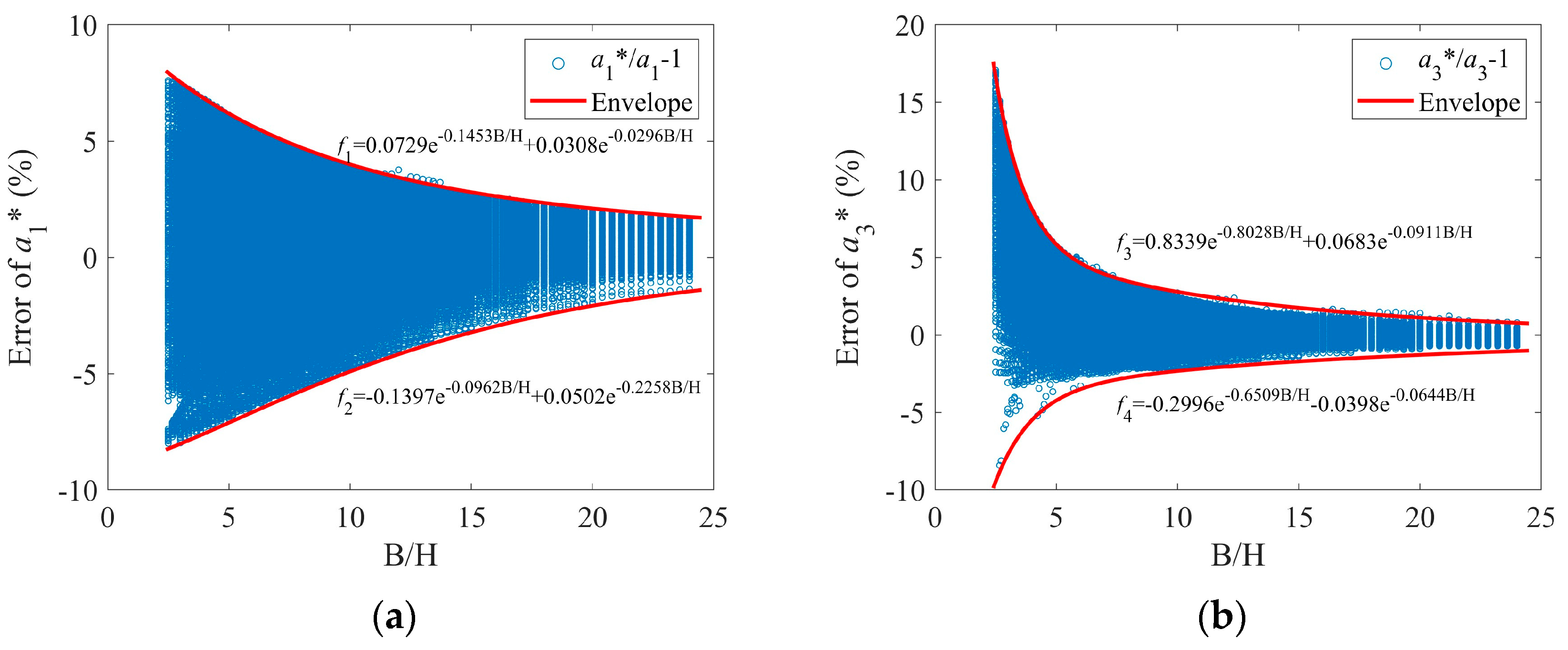



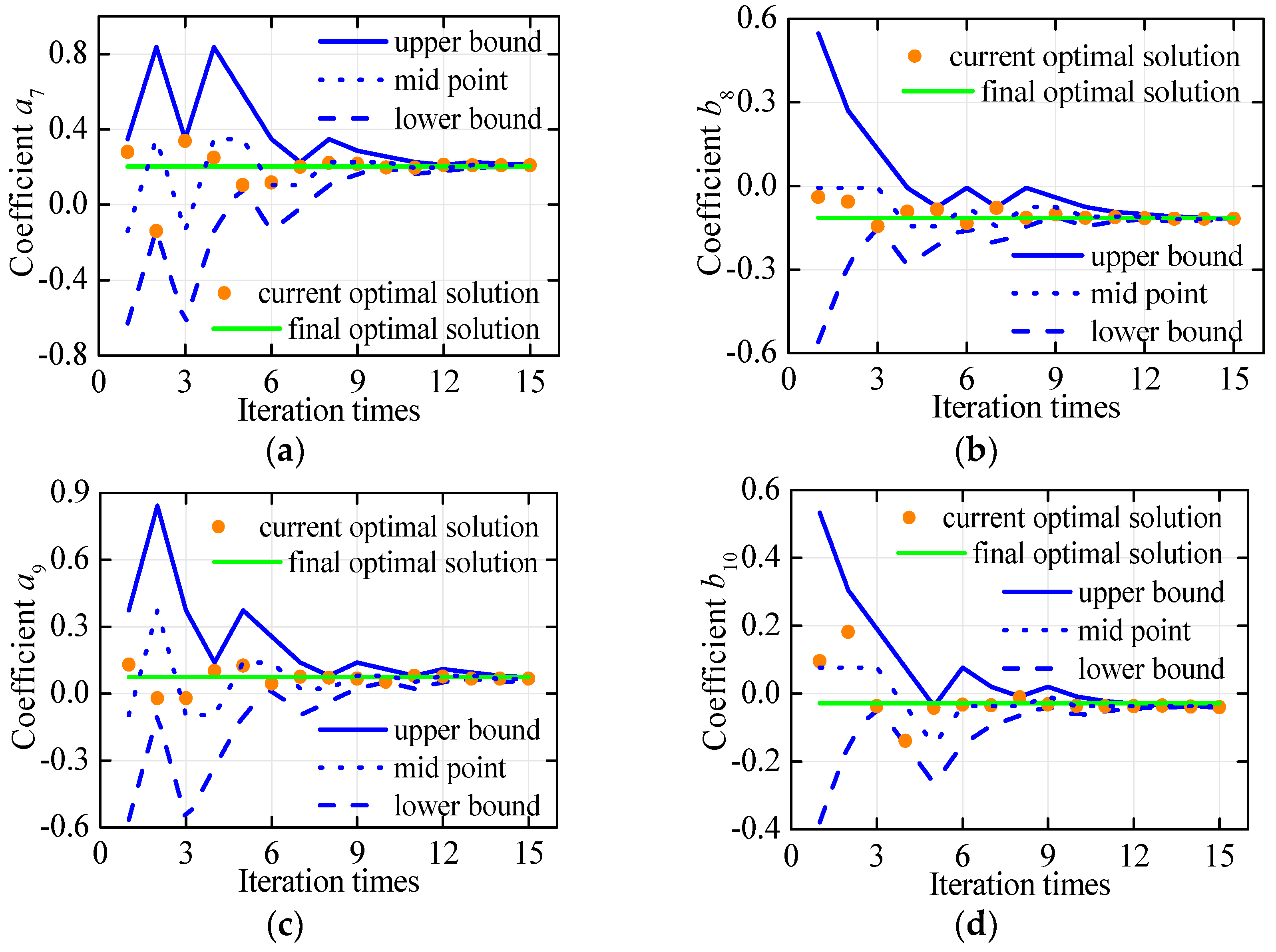
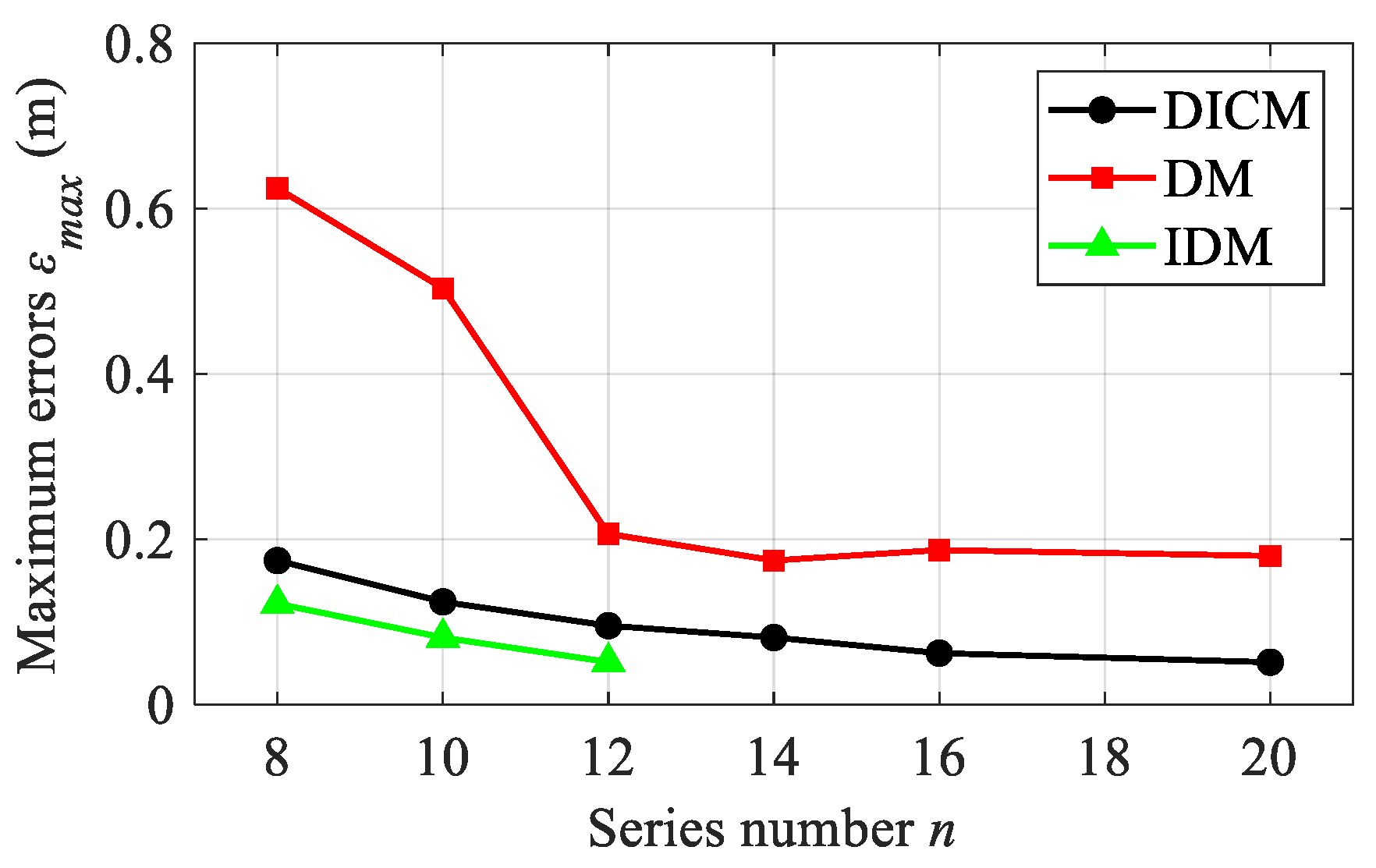
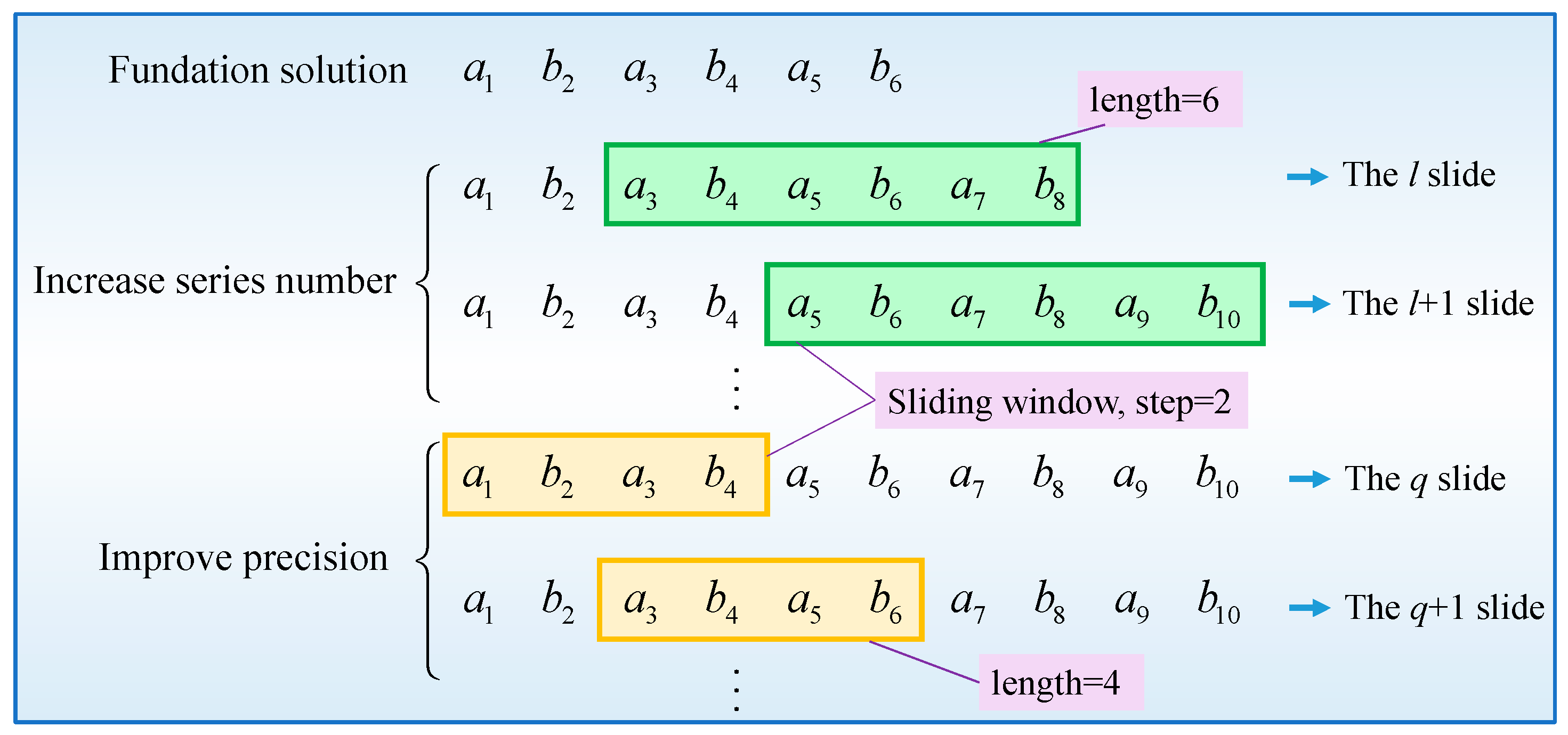

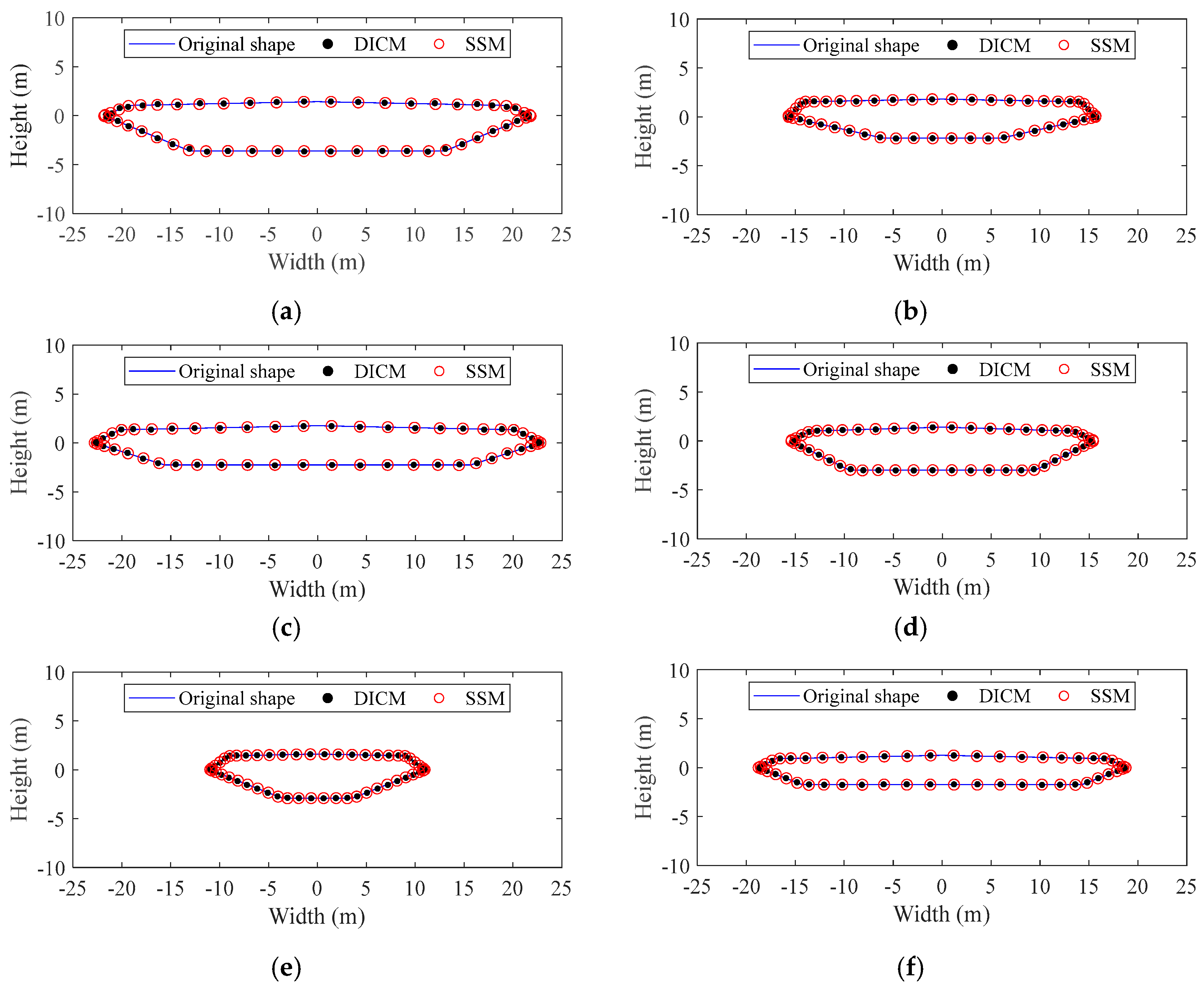
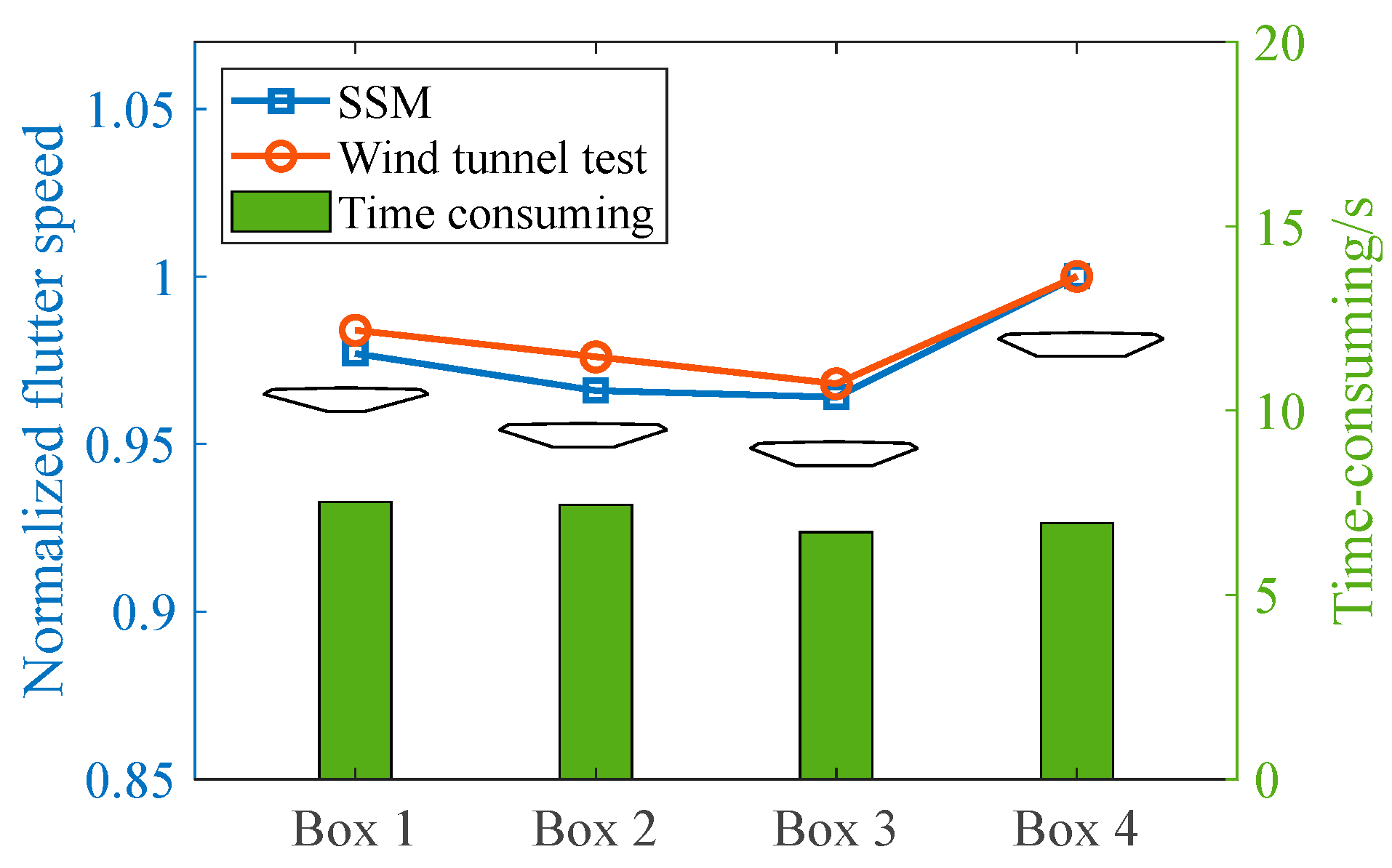
| k | 1 | 2 | 3 | 4 | 5 | 6 | 7 | 8 | 9 | 10 |
|---|---|---|---|---|---|---|---|---|---|---|
| 8.7621 | −1.5 × 10−4 | 6.4213 | 4.4 × 10−5 | −0.0841 | −4.6 × 10−6 | 0.1502 | −2.9 × 10−5 | 0.0771 | −4.6 × 10−5 | |
| 5.3 × 10−4 | −0.5759 | −4.2 × 10−4 | 0.4411 | 2.6 × 10−5 | 0.1616 | −6.1 × 10−5 | −0.0881 | −3.1 × 10−5 | −0.0450 |
| j | 1 | 2 | 3 | 4 | 5 |
| a2j−1 | (~) | (~) | −0.8770~0.6097 | −0.6294~0.3481 | −0.5646~0.3740 |
| b2j | −2.3874~0.6518 | −0.0434~1.2909 | −0.4762~0.5408 | −0.5597~0.5474 | −0.3782~0.5328 |
| j | 6 | 7 | 8 | 9 | 10 |
| a2j−1 | −0.5535~0.4761 | −0.4523~0.4350 | −0.4178~0.3847 | −0.3804~0.3798 | −0.3688~0.3697 |
| b2j | −0.4501~0.4792 | −0.4060~0.4203 | −0.3597~0.4136 | −0.3711~0.3768 | −0.3180~0.3512 |
| j | 11 | 12 | 13 | 14 | 15 |
| a2j−1 | −0.3596~0.2913 | −0.3104~0.3328 | −0.3018~0.2942 | −0.2155~0.2098 | −0.2327~0.2414 |
| b2j | −0.3369~0.3004 | −0.3136~0.3040 | −0.3038~0.2854 | −0.2887~0.2736 | −0.2467~0.2545 |
| j | 16 | 17 | 18 | 19 | 20 |
| a2j−1 | −0.2364~0.2441 | −0.2077~0.2158 | −0.2057~0.1724 | −0.1789~0.1484 | −0.1593~0.1736 |
| b2j | −0.2195~0.2164 | −0.1991~0.2090 | −0.1667~0.1845 | −0.1609~0.1605 | −0.1621~0.1557 |
| j | 21 | 22 | 23 | 24 | 25 |
| a2j−1 | −0.1441~0.1503 | −0.1280~0.1342 | −0.1164~0.1223 | −0.1068~0.0982 | −0.0873~0.0886 |
| b2j | −0.1557~0.1277 | −0.1138~0.1116 | −0.1438~0.1371 | −0.1458~0.1411 | −0.0861~0.0832 |
Disclaimer/Publisher’s Note: The statements, opinions and data contained in all publications are solely those of the individual author(s) and contributor(s) and not of MDPI and/or the editor(s). MDPI and/or the editor(s) disclaim responsibility for any injury to people or property resulting from any ideas, methods, instructions or products referred to in the content. |
© 2023 by the authors. Licensee MDPI, Basel, Switzerland. This article is an open access article distributed under the terms and conditions of the Creative Commons Attribution (CC BY) license (https://creativecommons.org/licenses/by/4.0/).
Share and Cite
Wu, L.; Zhou, Z.; Zhang, J.; Zhang, M. A Numerical Method for Conformal Mapping of Closed Box Girder Bridges and Its Application. Sustainability 2023, 15, 6291. https://doi.org/10.3390/su15076291
Wu L, Zhou Z, Zhang J, Zhang M. A Numerical Method for Conformal Mapping of Closed Box Girder Bridges and Its Application. Sustainability. 2023; 15(7):6291. https://doi.org/10.3390/su15076291
Chicago/Turabian StyleWu, Lianhuo, Zelin Zhou, Jinxiang Zhang, and Mingjin Zhang. 2023. "A Numerical Method for Conformal Mapping of Closed Box Girder Bridges and Its Application" Sustainability 15, no. 7: 6291. https://doi.org/10.3390/su15076291
APA StyleWu, L., Zhou, Z., Zhang, J., & Zhang, M. (2023). A Numerical Method for Conformal Mapping of Closed Box Girder Bridges and Its Application. Sustainability, 15(7), 6291. https://doi.org/10.3390/su15076291








